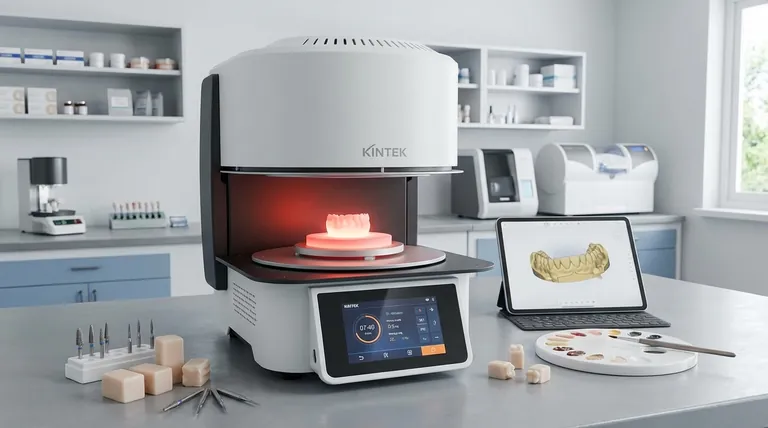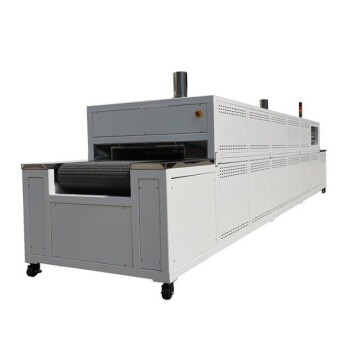In modern restorative dentistry, a furnace is a specialized, high-temperature oven used to process ceramic materials into their final, hardened state. These devices are essential for fabricating durable and aesthetic restorations such as crowns, bridges, veneers, inlays, and onlays from materials like zirconia or glass-ceramics. By precisely controlling heat and sometimes pressure, the furnace transforms a pre-milled or pressed restoration into a strong, biocompatible, and stable final product.
A dental furnace is not merely an oven; it is a precision instrument that governs the final strength, fit, and aesthetic properties of a ceramic restoration. The choice of furnace and firing cycle directly dictates the clinical success of the final prosthesis.

The Core Function: From Milled Block to Final Crown
A dental furnace's primary job is to induce specific microstructural changes in ceramic materials through a carefully controlled thermal cycle. This process is far more complex than simple heating.
Sintering for Ultimate Strength
Sintering is the process of heating a compacted powder material to a temperature below its melting point until its particles fuse together. This is the primary hardening process for materials like zirconia.
In its pre-sintered "green" or "chalky" state, zirconia is soft enough to be milled easily. The furnace then heats it to temperatures often exceeding 1,500°C (2,732°F), causing the individual zirconia particles to bond, eliminating porosity and shrinking the restoration to its final, dense, and incredibly strong form.
Crystallization for Aesthetics and Durability
For glass-ceramics, such as lithium disilicate, the furnace performs a crystallization cycle. The material is heated to a specific temperature where glass transforms into a crystalline structure.
This process dramatically increases the material's strength and establishes its final optical properties, such as translucency and shade. A separate, lower-temperature glazing cycle is often performed afterward to create a smooth, shiny, and stain-resistant surface.
Understanding the Different Types of Furnaces
Dental furnaces are not one-size-fits-all. They are designed for specific materials and processes, each with unique capabilities.
Sintering Furnaces
These are the high-heat workhorses of the dental lab, designed specifically to reach the extreme temperatures required to sinter zirconia. Their primary features are high-temperature capacity and precise, often lengthy, heating and cooling cycles.
Firing and Glazing Furnaces
These are the most common types of furnaces, used for firing porcelain onto metal substructures (PFMs) or for glazing and crystallizing glass-ceramic restorations. They operate at lower temperatures than sintering furnaces but require exceptional accuracy to achieve proper aesthetics.
Pressing Furnaces
These specialized furnaces add a mechanical component to the thermal process. A plunger uses pressure to press a heat-softened ceramic ingot into a mold. This is used for creating highly accurate restorations like pressed ceramic crowns and veneers.
Chairside Furnaces
The growth of in-office CAD/CAM dentistry has led to the development of compact, rapid-cycle furnaces. These "speed sintering" or crystallization ovens are optimized to process single crowns or small bridges in minutes rather than hours, making single-visit dentistry possible.
Key Considerations and Trade-offs
The performance of a furnace is defined by more than just its maximum temperature. Precision, speed, and material compatibility create a landscape of critical trade-offs.
Accuracy vs. Speed
While fast cycles are convenient for chairside applications, they can sometimes come at a cost. A slower, more controlled heating and cooling rate generally reduces thermal stress within the ceramic, which can lead to a stronger and more durable final restoration.
The Critical Role of Calibration
Inaccurate temperature readings can ruin a restoration. If a furnace runs too hot, it can cause the ceramic to melt or appear glassy and translucent. If it runs too cool, the material may not fully sinter or crystallize, resulting in a weak, opaque, or poorly fitting restoration. Regular calibration is non-negotiable for predictable results.
Material-Specific Programs
Every ceramic material has a unique firing schedule prescribed by its manufacturer. Using the wrong program—even if the temperature seems close—can compromise the physical and aesthetic properties of the material. A high-quality furnace allows for precise, programmable cycles tailored to each specific material.
Choosing the Right Furnace for Your Goal
The ideal furnace depends entirely on the primary focus of your practice or laboratory workflow.
- If your primary focus is high-volume zirconia production: Invest in a large-capacity sintering furnace known for its reliability and ability to handle long, overnight cycles.
- If your primary focus is single-visit chairside dentistry: A compact, rapid-sintering furnace that integrates seamlessly with your in-office milling unit is the essential choice.
- If your primary focus is high-end aesthetic restorations: Prioritize a firing and glazing furnace with exceptional temperature accuracy and customizable programs to perfect the characterization of glass-ceramics and layered porcelain.
- If your primary focus is pressed ceramics: A dedicated pressing furnace is required, as its function cannot be replicated by other furnace types.
Ultimately, the dental furnace is the final gatekeeper of quality, transforming a digital or manual design into a successful clinical reality.
Summary Table:
| Furnace Type | Primary Function | Key Materials | Typical Use Case |
|---|---|---|---|
| Sintering Furnace | Fuses zirconia particles at high heat | Zirconia | High-volume lab production of crowns/bridges |
| Firing/Glazing Furnace | Crystallizes & glazes glass-ceramics | Lithium Disilicate, Porcelain | Aesthetic veneers, layered restorations |
| Pressing Furnace | Presses heated ceramic into a mold | Pressable Ceramics | Accurate pressed crowns and veneers |
| Chairside Furnace | Rapid sintering/crystallization | Zirconia, Glass-Ceramics | Single-visit, in-office CAD/CAM dentistry |
Ready to achieve unparalleled precision and strength in your dental restorations?
At KINTEK, we leverage our exceptional R&D and in-house manufacturing to provide dental laboratories with advanced, high-temperature furnace solutions. Our product line, including precise Sintering, Firing/Glazing, and specialized furnaces, is complemented by strong deep customization capabilities to meet your unique workflow and material requirements.
Contact us today (#ContactForm) to discover how a KINTEK furnace can become the reliable cornerstone of your lab's quality and efficiency.
Visual Guide

Related Products
- Chairside Dental Porcelain Zirconia Sintering Furnace with Transformer for Ceramic Restorations
- Dental Porcelain Zirconia Sintering Ceramic Vacuum Press Furnace
- 1700℃ Controlled Inert Nitrogen Atmosphere Furnace
- Vacuum Sealed Continuous Working Rotary Tube Furnace Rotating Tube Furnace
- 1700℃ High Temperature Laboratory Tube Furnace with Quartz or Alumina Tube
People Also Ask
- Why is temperature range important when selecting a dental furnace? Unlock Material Compatibility and Precision
- What is the importance of dental furnaces in dentistry? Ensure Strong, Precise Dental Restorations
- What are the recommended maintenance practices for dental furnaces? Ensure Precision and Longevity for Your Lab
- What safety measures should be followed when using a sintering furnace in dental labs? Ensure Safe, High-Quality Dental Restorations
- What are some key features of dental sintering and porcelain furnaces? Optimize Your Dental Lab's Workflow



















